Canon EF400 User Manual
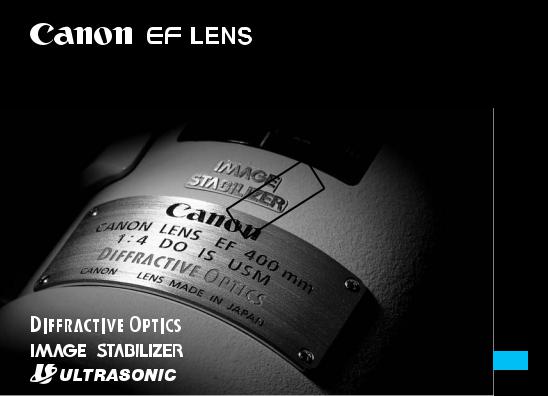
EF400mm f/4 DO IS USM
COPY
ENG
Instruction
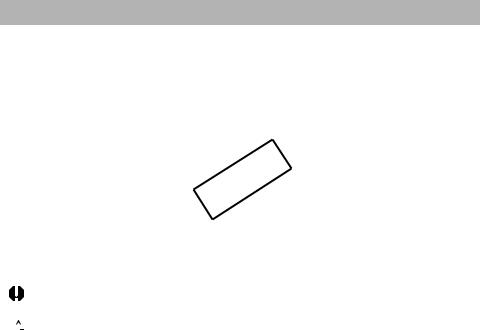
Thank you for purchasing a Canon product.
The Canon EF400mm f/4 DO IS USM lens is a |
Features |
||||||||
high-performance, super telephoto lens |
|
|
|||||||
1. |
The multi-layer diffractive optical element effectively |
||||||||
dedicated to Canon EOS cameras. Besides |
|||||||||
|
corrects chromatic aberrations prone to occur in super |
||||||||
having an Image Stabilizer, it is the world's |
|
telephoto lenses. It provides high image quality while |
|||||||
first camera lens incorporating a multi-layer |
|
maintaining compactness and light weight. |
|||||||
diffractive optical element (DO). |
|
|
2. |
The Image Stabilizer gives the equivalent effect of a |
|||||
The multi-layer diffractive optical element is a |
|
shutter speed two stops faster*. |
|||||||
revolutionary element having the |
|
|
|
The lens also has a second image stabilizer mode that is |
|||||
characteristics of both fluorite and aspherical |
|
optimized for following shots of moving subjects. |
|||||||
elements. It greatly contributes to the lens' |
3. |
Ultrasonic motor (USM) for quick and quiet autofocusing. |
|||||||
compactness, light weight, and high image |
4. |
Manual focusing is available after the subject comes into |
|||||||
quality. |
|
|
|
focus in autofocus mode (ONE SHOT AF). |
|||||
|
|
|
|
|
COPY |
||||
• "DO" stands for Diffractive Optics. |
|
|
5. |
The AF Stop button for stopping the AF operation at |
|||||
|
|
|
anytime. |
||||||
• "IS" stands for Image Stabilizer. |
|
|
|
||||||
|
|
6. |
The lens is compatible with Extender EF1.4X ll and |
||||||
• "USM" stands for Ultrasonic Motor. |
|
|
|||||||
|
|
|
EF2X ll. |
||||||
|
|
|
|
|
|
|
|
||
Conventions used in this instruction |
|
|
7. |
Tight seal structure ensures excellent dust-proof and |
|||||
|
|
|
|
Warning to prevent lens or camera malfunction |
|
|
drip-proof performance. |
||
|
|
|
|
|
8. |
Designed for lighter weight with major parts made of |
|||
|
|
|
|
or damage. |
|
|
|||
|
|
|
|
|
|
|
magnesium alloy. |
||
|
|
|
|
Supplementary notes on using the lens and |
|
|
|||
|
|
|
|
|
* Based on [1/focal length] second. Generally, it requires |
||||
|
|
|
|
|
|||||
|
|
|
|
taking pictures. |
|
|
|||
|
|
|
|
|
|
|
a shutter speed [1/focal length] second or faster to |
||
|
|
|
|
|
|
|
prevent camera shake. |
||
ENG-1
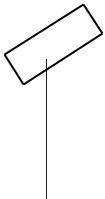
|
|
|
|
|
|
|
|
This device complies with Part 15 of the FCC Rules. Operation is |
|
a Safety Precautions |
|
|||
|
subject to the following two conditions: (1) This device may not |
|||
• |
Do not look at the sun or a bright light source |
|
cause harmful interference, and (2) this device must accept any |
|
|
through the lens or camera. Doing so could result in |
|
interference received, including interference that may cause |
|
|
|
undesired operation. |
||
|
loss of vision. Looking at the sun directly through the |
|
||
|
|
Do not make any changes or modifications to the equipment |
||
|
lens is especially hazardous. |
|
||
|
|
unless otherwise specified in the instructions. If such changes or |
||
• |
Whether it is attached to the camera or not, do not |
|
modifications should be made, you could be required to stop |
|
|
leave the lens under the sun without the lens cap |
|
operation of the equipment. |
|
|
attached. This is to prevent the lens from concentrating |
|
This equipment has been tested and found to comply with the limits |
|
|
the sun’s rays, which could cause a fire. |
|
for a class B digital device, pursuant to part 15 of the FCC Rules. |
|
|
|
These limits are designed to provide reasonable protection against |
||
• |
Do not stand on the lens case. Falling off the case |
|
||
|
harmful interference in a residential installation. This equipment |
|||
|
could result in injury. |
|
||
|
|
generates, uses and can radiate radio frequency energy and, if not |
||
• |
Do not stack lens cases. A falling lens case could |
|
||
|
installed and used in accordance with the instructions, may cause |
|||
|
cause an injury. |
|
harmful interference to radio communications. |
|
|
|
|
However, there is no guarantee that interference will not occur in a |
|
|
|
|||
|
|
|
particular installation. If this equipment does cause harmful |
|
Handling Cautions |
||||
|
interference to radio or television reception, which can be determined |
|||
• |
If the lens is taken from a cold environment intoCOPYa by turning the equipment off and on, the user is encouraged to try to |
|||
|
warm one, condensation may develop on the lens |
|
correct the interference by one or more of the following measures: |
|
|
surface and internal parts. To prevent condensation |
|
• Reorient or relocate the receiving antenna. |
|
|
in this case, first put the lens into an airtight plastic bag |
|
• Increase the separation between the equipment and receiver. |
|
|
|
• Consult the dealer or an experienced radio/TV technician for help. |
||
|
before taking it from a cold to warm environment. Then |
|
||
|
|
|
||
|
take out the lens after it has warmed gradually. Do the |
|
This Class B digital apparatus complies with Canadian ICES-003. |
|
|
same when taking the lens from a warm environment |
|
|
|
|
|
|
||
|
into a cold one. |
|
a Shooting Precautions |
|
• Do not leave the lens in excessive heat such as in a |
|
|||
|
car in direct sunlight. High temperatures can cause |
|
If a very bright spotlight like a mercury lamp is |
|
|
|
photographed in a dark place with this lens, a |
||
|
the lens to malfunction. |
|
||
|
|
|
halo of light may occasionally appear around the |
|
|
|
|||
|
|
|
light source because of the DO elements. |
|
|
|
|
ENG-2 |
|
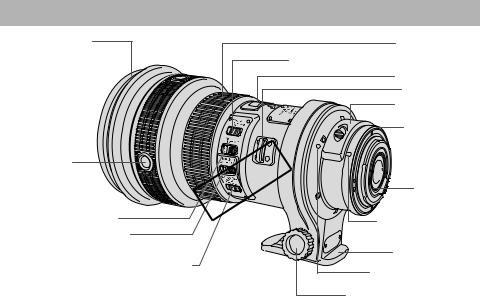
Nomenclature |
|
Hood mount (→ 10) |
Focusing ring (→ 5) |
|
Focusing distance range selection switch (→ 5) |
|
Distance scale (→ 6) |
|
Strap mount (→ 4) |
|
Drop-in filter (→ 12) |
|
Rubber ring (→ 4) |
AF stop button |
COPY |
|
(→ 6) |
|
|
|
Contacts (→ 4) |
|
Focus mode switch (→ 5) |
Lens mount index (→ 4) |
|
|
|
|
Image stabilizer switch (→ 7) |
|
|
|
|
Tripod mount (→ 11) |
Image stabilizer mode selector switch (→ 7) |
|
Tripod collar index (→ 11) |
|
|
|
|
|
Orientation locking knob (→ 11) |
For detailed information, reference page numbers are provided in parentheses (→ **). |
||
ENG-3
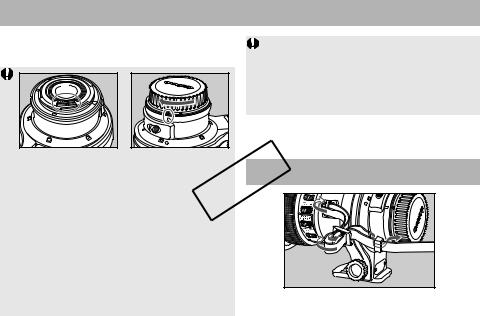
1. Mounting and Detaching the Lens
See your camera’s instructions for details on mounting and detaching the lens.
The lens mount has a rubber ring for enhanced waterand dust-resistance. The rubber ring may cause slight abrasions around the camera's lens mount, but this will not cause any problems. If the rubber ring becomes worn, it is replaceable by a Canon Service Center at cost.
• After detaching the lens, place the lens with the |
|
|
|
COPY |
|
rear end up to prevent the lens surface and |
Attaching the strap |
|
electrical contacts from getting scratched. |
|
|
• If the contacts get soiled, scratched, or have |
|
|
fingerprints on them, corrosion or faulty |
|
|
connections can result. The camera and lens |
|
|
may not operate properly. |
|
|
•If the contacts get soiled or have fingerprints on them, clean them with a soft cloth.
•If you remove the lens, cover it with the dust cap. To attach it properly, align the lens mount index and the K index of the dust cap as shown in the diagram, and turn clockwise. To remove it, reverse the order.
ENG-4
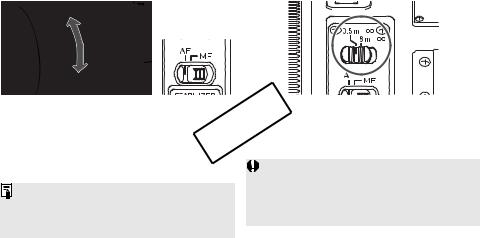
2. Setting the Focus |
|
3. Switching the Focusing |
||||||||||||
Mode |
|
Distance Range |
||||||||||||
|
|
|
|
|
|
|
|
|
|
|
|
|
|
|
|
|
|
|
|
|
|
|
|
|
|
|
|
|
|
|
|
|
|
|
|
|
|
|
|
|
|
|
|
|
|
|
|
|
|
|
|
|
|
|
|
|
|
|
|
|
|
|
|
|
|
|
|
|
|
|
|
|
|
|
|
|
|
|
|
|
|
|
|
|
|
|
|
|
|
|
|
|
|
|
|
|
|
|
|
|
|
|
|
|
|
|
|
|
|
|
|
|
|
|
|
|
|
|
|
To shoot in autofocus (AF) mode, set the focus |
ou can set the focusing distance range to |
|
mode switch to AF. |
|
3.5 m/11.5 ft. to infinity or 8 m/26.2 ft. to infinity. |
To use only manual focusing (MF), set the focus |
By setting the suitable focusing distance range, |
|
mode switch to MF, and focus by turning the |
the actual autofocusing time can be shorter. |
|
focusing ring. The focusing ring always works, |
|
|
regardless of the focus mode. |
COPY |
|
|
If you autofocus outside the set focusing distance |
|
|
|
range, the lens may stop focusing at the start of |
After autofocusing in ONE SHOT AF mode, focus |
the focusing range; however, this is not a |
|
manually by pressing the shutter button halfway |
malfunction. Press the shutter release button |
|
and turning the focusing ring. (Full-time manual |
halfway again. |
|
focus) |
|
|
ENG-5
